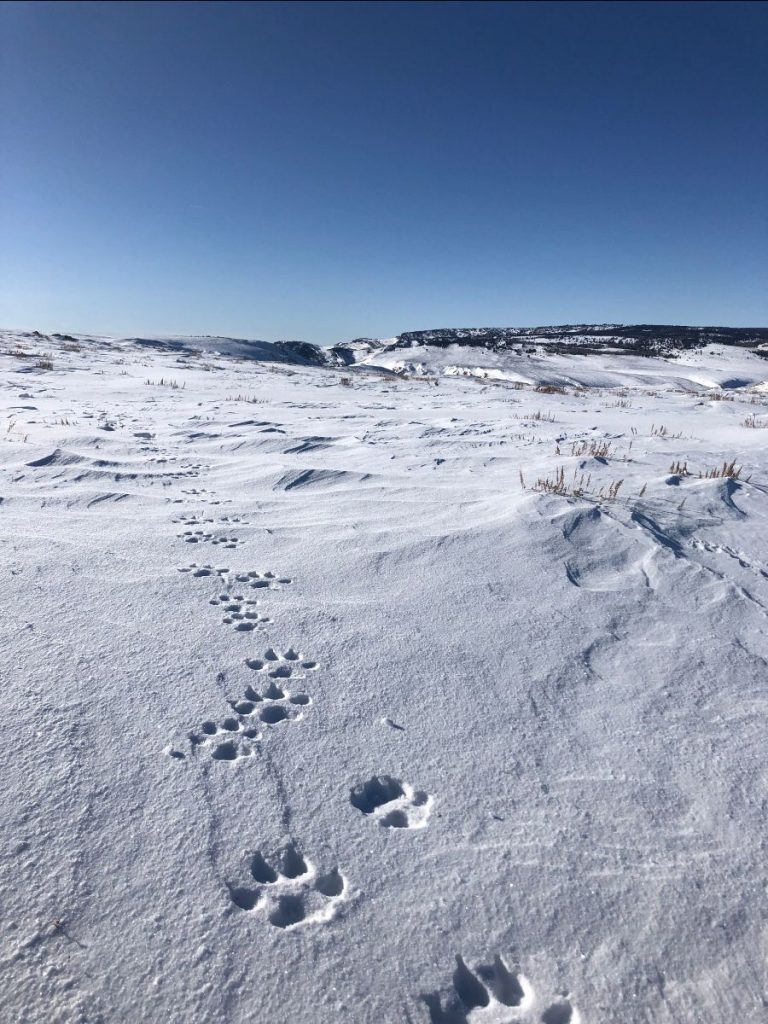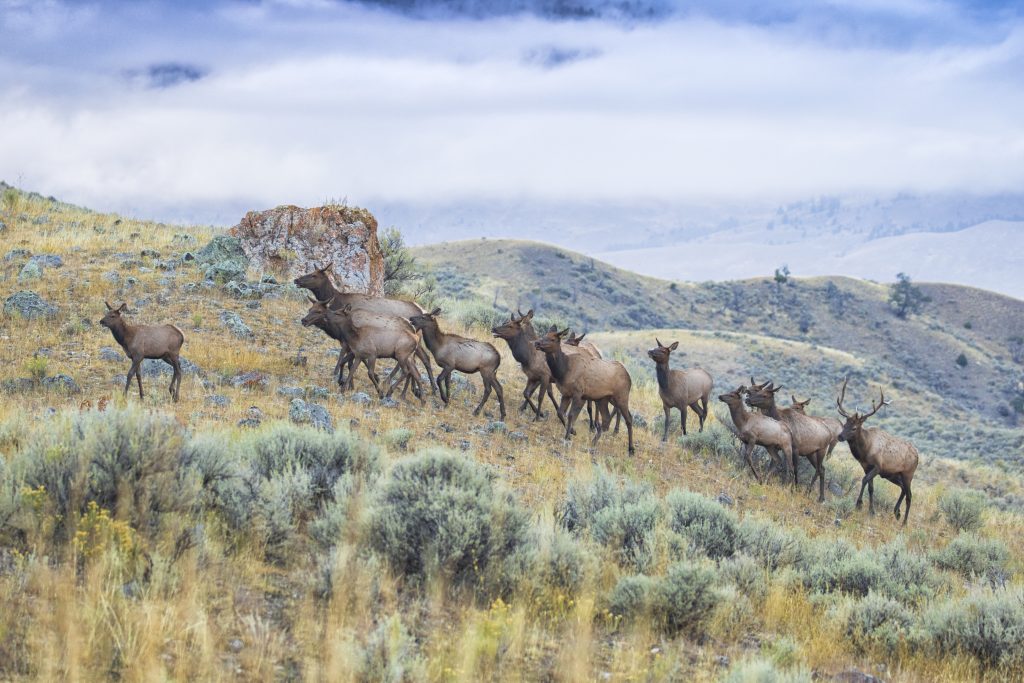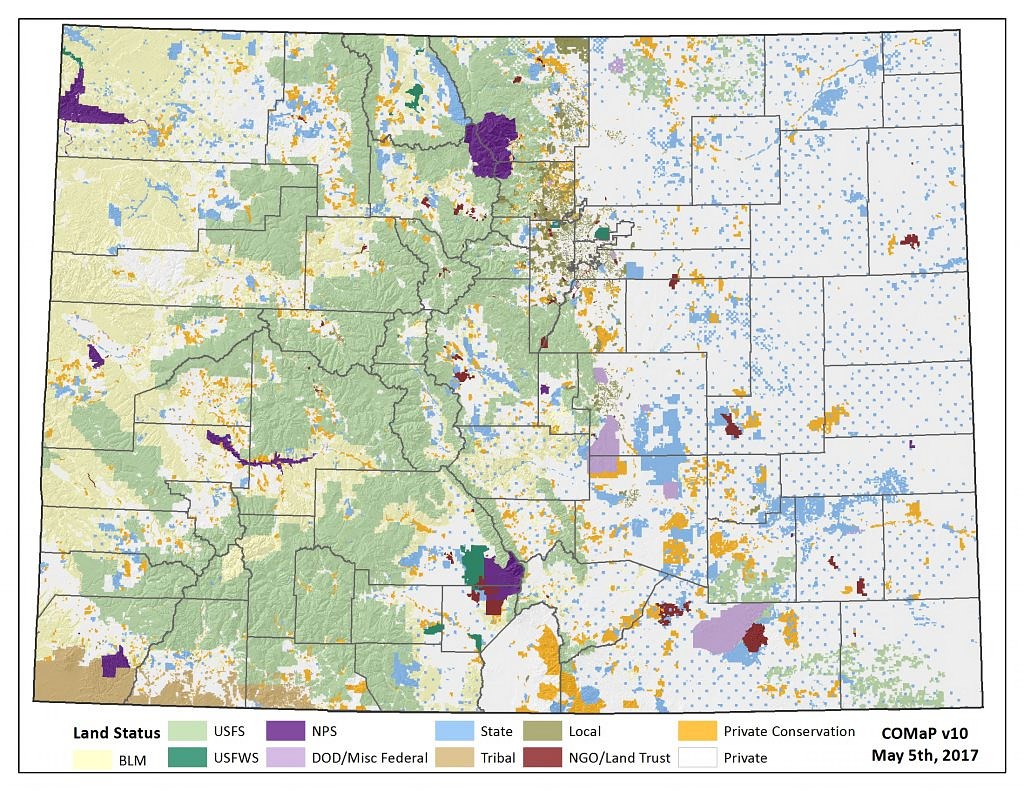by the Center for Human-Carnivore Coexistence (5/20)
Key Points….
- The gray wolf is native to Colorado but was eradicated from the state by the mid-1940s.
- Colorado still has suitable habitat for wolves, including a sufficient prey base and extensive public land.
- A few individual wolves have arrived in Colorado during the past two decades and a small group currently lives in the state, but it is unclear if and when Colorado would have a self-sustaining viable population of wolves. Reintroducing more wolves would reduce uncertainty and increase the likelihood of a viable population.
The history and current status of wolves in Colorado
The gray wolf is native to Colorado.1-3 Historically, wolves were distributed in Colorado throughout all major habitat types. During the latter half of the 1800s, hunters decimated wolf prey such as bison, elk, and deer. By the early 1900s, less than 1000 elk remained in Colorado3, compared to over a quarter million elk today.4 At the same time, domestic livestock were increasing in numbers, providing an alternative prey source for wolves. Because wolves killed livestock and game, by the mid-1940’s, wolves were eradicated from Colorado by shooting, trapping, and poisoning.5-7 Similarly, government sponsored predator control eliminated wolves throughout most of the western United States. Wolves were restored to Yellowstone National Park in the mid 1990’s and over the ensuing decades Colorado Parks and Wildlife is aware of a few lone wolves that have made it to Colorado.8 These wolves died from vehicle collisions, shooting, or poisoning, or they simply disappeared. It is possible, if not likely, that other wolves have made their way into Colorado and have not been observed.

More recently, a lone wolf was confirmed in north-central Colorado near Walden in July 2019.6 This male wolf had a radio-collar that showed it came from west-central Wyoming. In January 2020, a group of up to 6 wolves was confirmed in Moffat County in northwest Colorado.9 These wolves likely migrated from a nearby state, perhaps Wyoming. It is uncertain if they will stay in Colorado.
Wolves are currently listed as “endangered” under federal and state law (see Wolf Policy Information Sheet). The federal law protecting wolves is the U.S. Endangered Species Act (ESA). The state law is Colorado’s Nongame, Endangered, or Threatened Species Conservation Act. For endangered species, federal law takes precedence over state law. Thus, wolves that arrive in Colorado are under the management authority of the U.S. Fish and Wildlife Service and not Colorado Parks and Wildlife.6 The ESA makes it unlawful to harm, harass, or kill a wolf, except if there is an immediate threat to human safety.
Can Colorado still support wolves?
Although wolves were eliminated from the state in the 1940s, Colorado still retains suitable habitat for wolves.10-13 Wolves can live in a variety of habitat types and can persist where there is enough prey and they are tolerated by humans. In the western United States, the best habitat for wolves is on public lands where both these needs are met (see Wolf Taxonomy and Biology Information Sheet).

Prey abundance is one of the best predictors of where wolves can live, and Colorado supports a sufficient prey base for wolves.10 If wolves re-establish in Colorado, either naturally or through reintroduction, it will likely initially be on the Western Slope (see Wolf Policy Information Sheet). As such, elk and mule deer would be the primary prey. Over 430,000 mule deer live in the state.14 Colorado also supports over 280,000 elk, the largest elk population of any state.4 The largest big game herds occur on the Western Slope (see Wolves, Big Game, and Hunting Information Sheet).
Colorado also has over 24 million acres of public lands, mostly federally owned.15 Of all the U.S. states, Colorado ranks 11th in total acres of federal land. This includes over 3.5 million acres of federally protected wilderness, ranking 6th among all U.S. states.16 Most of these public lands are in western Colorado (Figure 1).17 Because public lands, especially wilderness areas, have less human disturbance, these areas would likely serve as important habitat for wolves.
Multiple scientific studies have concluded that Colorado can sustain a population of wolves.10-13 A study published in 1994 indicated that Colorado could support over 1000 wolves.11 A study published in 2006 predicted that, after forecasting increased human population growth and road development, Colorado could support at least 400 wolves by 2025.13 Another study published in 2017 identified western Colorado as prime for wolf restoration.10 Updated studies are necessary to estimate how many and where wolves could live in Colorado both now and into the future.

Ultimately, people will determine where wolves can live.10 Wolves once were the most widely distributed land mammal worldwide. Today, they inhabit parts of North America, Europe, and Asia. As long as people tolerate them, wolves can persist in regions with many people.10,12 For example, over 2,300 wolves live in Minnesota18, a state with 5.6 million people and an average population density of 71 people per square mile.19 About 850 wolves live in Wisconsin18, a state with 5.8 million people and an average population density of 107 people per square mile.19 For comparison, Colorado has 5.8 million people and an average population density of 56 people per square mile.19 Colorado’s population is heavily concentrated in the Front Range, with only about 10% of residents living in the Western Slope. As another comparison, over 11,000 wolves now live in Europe, including near large cities. This is about twice as many wolves as the 6000 wolves that now live in the lower 48 U.S. states.10 Europe is half the area of the lower U.S. with twice the average human population density.20
The best habitat for wolves in Colorado would be public lands where there is abundant prey and open space and less potential for conflict with people.12 Much of the more remote public lands, particularly wilderness areas, are at higher elevations. In some areas, wolf prey like elk and deer seasonally migrate to lower elevations during winter. This includes private lands in valley bottoms, which can be productive21 and a refuge from hunting and thus attractive to wildlife.22 If wolves follow their prey to private lands, this would increase the risk of conflict with people and livestock. Conversely, grazing of livestock on public land where wolves reside would also increase the risk of conflict. A variety of strategies are available to prevent and reduce such conflicts (see Wolves and Livestock Information Sheet and Wolves and Human Safety Information Sheet).
Wolves currently live in Colorado, so why do some people still want to reintroduce more wolves?
An important conservation goal for endangered species is that they recover to form a self-sustaining and viable population.13 A viable population has sufficient numbers and geographic distribution such that it can persist over the long-term. The wolves currently in northern Colorado – a single group of six wolves and another lone wolf – are not a sustainable viable population over the long-term. These wolves are at risk. They might be killed or disappear, as has happened to other wolves that have migrated to Colorado.8 Also, while protected in Colorado, wolves that cross into Wyoming have no legal protection in most of the state.23 Further, unpredictable events like disease can quickly eliminate such a small group of wolves, and these few animals contain a limited gene pool which can reduce the chance of long-term persistence. Thus, it is uncertain if the wolves currently in Colorado will grow to form a viable population in the state. It is also unclear if and when a viable population would arise from continued colonization from nearby states. Reintroducing wolves would greatly reduce both sources of uncertainty.
References
- Colorado Parks and Wildlife. 2020. Wolves.
- Cary, M. 1911. A biological survey of Colorado. North American Fauna No. 33. Government Printing Office. 256pp.
- Armstrong, D. 1972. Distribution of Mammals in Colorado. Monograph of the Museum of Natural History, the University of Kansas. Number 3. 415pp.
- Colorado Parks and Wildlife. 2020. Elk Hunting Statistics.
- Carhart, A., 2017. The Last Stand of the Pack: Critical Edition. University Press of Colorado.
- Colorado Parks and Wildlife. 2020. Wolf Management.
- Colorado Parks and Wildlife. 2020. Colorado’s Mule Deer Story; 1900-1930: Wildlife on the Brink.
- Colorado Parks and Wildlife. 2020. Information on Wolves and QA Final.
- Colorado Parks and Wildlife. 2020. February 13 2020 Colorado Parks and Wildlife News Release: Genetic tests confirm presence of wolves in Colorado.
- Mech, L.D., 2017. Where can wolves live and how can we live with them?. Biological conservation, 210, pp.310-317.
- Bennett, L.E., 1994. Colorado Gray Wolf Recovery: Biological Feasibility Study. U.S. Fish and Wildlife Service.
- Carroll, C., Phillips, M.K., Schumaker, N.H. and Smith, D.W., 2003. Impacts of landscape change on wolf restoration success: planning a reintroduction program based on static and dynamic spatial models. Conservation Biology, 17(2), pp.536-548.
- Carroll, C., Phillips, M.K., Lopez-Gonzalez, C.A. and Schumaker, N.H., 2006. Defining recovery goals and strategies for endangered species: the wolf as a case study. BioScience, 56(1), pp.25-37.
- Colorado Parks and Wildlife. 2020. Deer Hunting Statistics.
- Congressional Research Service. 2020. Federal Land Ownership: Overview and Data.
- Congressional Research Service. 2019. Wilderness: Overview, Management, and Statistics.
- Colorado Natural Heritage Program. 2020. COMaP – Colorado Ownership, Management and Protection database.
- U.S. Fish & Wildlife Service. 2020. Gray Wolf. Current Population in the United States.
- United States Census Bureau. 2020. State Population Totals and Components of Change: 2010-2019.
- Chapron, G., Kaczensky, P., Linnell, J.D., von Arx, M., Huber, D., Andrén, H., López-Bao, J.V., Adamec, M., Álvares, F., Anders, O. and Balčiauskas, L., 2014. Recovery of large carnivores in Europe’s modern human-dominated landscapes. science, 346(6216), pp.1517-1519.
- Robinson, N.P., Allred, B.W., Naugle, D.E. and Jones, M.O., 2019. Patterns of rangeland productivity and land ownership: Implications for conservation and management. Ecological applications, 29(3), p.e01862.
- Walter, W.D., Lavelle, M.J., Fischer, J.W., Johnson, T.L., Hygnstrom, S.E. and VerCauteren, K.C., 2011. Management of damage by elk (Cervus elaphus) in North America: a review. Wildlife Research, 37(8), pp.630-646.
- Wyoming Game and Fish. 2020. Learn more about wolves and Wyoming’s laws and regulations





